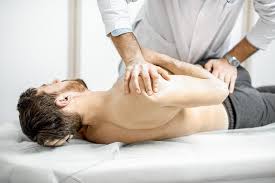
Osteopathic Manipulation and Massag
Osteopathic manipulative therapy (OMT) is a medical technique that especially emphasizes manipulating a patient’s joints and soft tissues to diagnose and treat a wide array of medical problems including back pain. The therapy is traced back to about 150 years ago, when the osteopathic medicine sprang from a need by physicians to provide holistic care, acknowledging that illnesses affect the entire body, not just isolated parts.
Today there’s a large group of people who confuse OMT with other therapies like massage because both techniques follow a hands-on approach to care. In fact OMT and massage are quite different in many ways, and understanding those differences is necessary for making sure you get the best care; especially for people who’re recovering from an injury or have musculoskeletal symptoms.
In this post you will discover what osteopathic manipulation for back pain is and how it differs from massage.
Osteopathic Manipulation vs. Massage
Most people admit that getting a massage is an effective way to relieve stress and experience deep relaxation. Various types of massages can stimulate circulation and cut down the strain that is associated with poor posture and other habits including a sedentary lifestyle.
However, while massage can be a good complementary therapy for pain and injuries involving soft tissues, it doesn’t offer a comprehensive treatment for most injuries and ailments involving acute or chronic pain.
On the other hand, osteopathic manipulation for back pain is a medical therapy focused on the comprehensive treatment of conditions associated with joints, soft and connective tissues, nerves, and other parts of the musculoskeletal system.
Following individuals are specially recommended for osteopathic manipulative therapy:
- Sports injuries
- Back pain
- Neck pain
- Arthritis
- Strained muscles
- Sprained ligaments
- Joint pain
- Nerve-related pain
Every care plan starts with a thorough physical exam to ensure OMT is the right approach. As the treatment continues, the trained therapist uses a series of thrusts and other specific and targeted movements to relieve pain and encourage total rejuvenation and wellness. Based on your individual needs, the team may recommend a variety of OMT techniques, such as:
- Myofascial release
- Soft tissue stretching
- Muscle energy technique
- Osteopathic cranial manipulative techniques
The therapist performing OMT for back pain, neck pain, etc., also offers lifestyle guidance and at-home exercises to ensure continuous healing and prevent relapse or recurrence.
What Happens During Your Visit?
A typical massage visit starts with a short review of your concerns, before the massage happens. Osteopathic manipulative therapy starts with a physical exam done by a doctor trained in osteopathic techniques. At the time of the visit, you need to go through an exam, including a hands-on assessment to find out the specific areas of weakness or discomfort to help the therapist’s team design an optimal treatment plan. Therapy may be performed using hands-on techniques or special instruments tailor-designed for OMT.
Then, the team works with you to teach you specialized at-home exercises, together with lifestyle guidance to guide your treatment in the right direction. Regular check-ins ensure you get uninterrupted therapies individualized to your needs as healing progresses, keeping you on the road to greater comfort and better health.
Depending on the technique used, your therapist/s may ask you to lay on your back, roll onto your side, or tuck your knees in. While you’re in these positions, your therapist will use pressure and light manipulation to stretch your muscles and wiggle your joints into proper alignment. Your therapist may ask you to hold and release your breath at certain moments.
Your therapist will use slow, continuous pressure or quick, sudden manipulations. Certain movements may feel a little odd or awkward, but they would hardly be painful. If you feel pain or discomfort during treatment, tell your provider at once.
Who’s Recommended Osteopathic Manipulative Treatment (OMT)?
In general people get OMT to treat lower back pain, neck pain or migraines, but doctors may use OMT to treat various other conditions. Babies, children, and adults all can make the most of osteopathic manipulative treatment. Pregnant women can get OMT to improve sleep and relieve pain. OMT may also help infants who have colic, face breastfeeding difficulties. Or have chronic ear infections.
People who suffer an undiagnosed pain will receive a consultation before osteopathic manipulation to determine whether the treatment is right for them.
The Nutshell
Osteopathic manipulation for back pain, including neck pain and migraines, is a modern approach that assures lasting relief, without the common side effects associated with other types of therapies.









